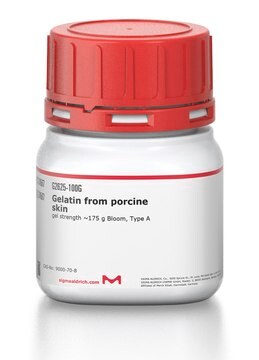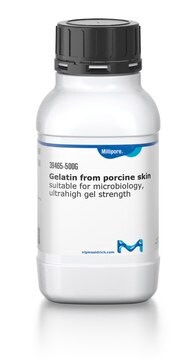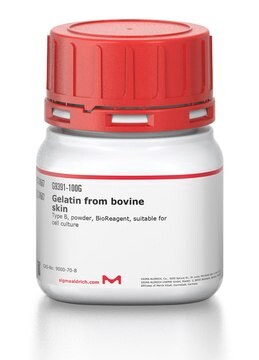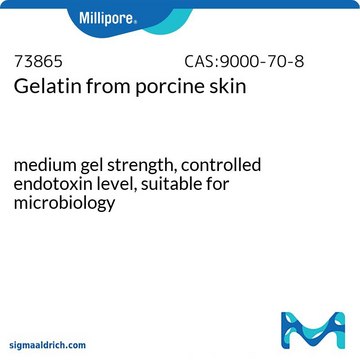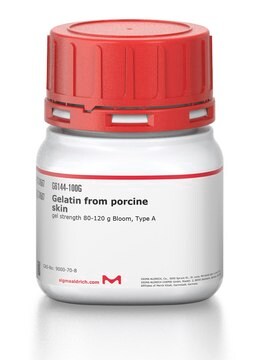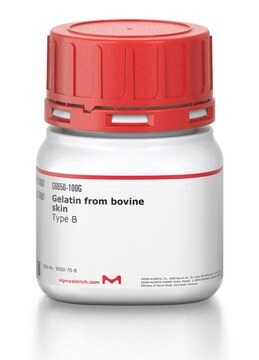48720
Gelatina
suitable for microbiology, low gel strength
About This Item
Produtos recomendados
fonte biológica
Porcine
Nível de qualidade
esterilidade
non-sterile
forma
powder
qualidade
low gel strength
resíduo de ignição
≤2%
perda
≤15% loss on drying
pH
4.0-6.0 (50 °C, 67 mg/mL in H2O)
força do gel
90-110 g Bloom (67 mg/ml water)
solubilidade
H2O: 67 mg/mL at 50 °C, slightly hazy, light brownish-yellow
traços de ânion
chloride (Cl-): ≤2000 mg/kg
traços de cátion
Ca: ≤2000 mg/kg
Cd: ≤5 mg/kg
Co: ≤5 mg/kg
Cr: ≤10 mg/kg
Cu: ≤50 mg/kg
Fe: ≤50 mg/kg
K: ≤500 mg/kg
Mg: ≤500 mg/kg
Mn: ≤5 mg/kg
Na: ≤3000 mg/kg
Ni: ≤5 mg/kg
Pb: ≤5 mg/kg
Zn: ≤10 mg/kg
aplicação(ões)
microbiology
Procurando produtos similares? Visita Guia de comparação de produtos
Categorias relacionadas
Aplicação
Gelatin has been used in many applications. It has use in coating cell culture to improve attachment of cells, being added to PCR to stabilize Taq DNA, as a blocking reagent in Western blotting, ELISA, and immunochemistry, and as a component of media for species differentiation in bacteriology. As a biocompatible polymer, it has used as a delivery vehicle for release of active biomolecules and in generation of scaffolds for tissue engineering applications. In the pharmaceutical industry, geltan can be used as a suspending and encapsulating agent, among other applications.
Componentes
Atenção
Outras notas
Código de classe de armazenamento
11 - Combustible Solids
Classe de risco de água (WGK)
nwg
Ponto de fulgor (°F)
Not applicable
Ponto de fulgor (°C)
Not applicable
Equipamento de proteção individual
Eyeshields, Gloves, type N95 (US)
Choose from one of the most recent versions:
Já possui este produto?
Encontre a documentação dos produtos que você adquiriu recentemente na biblioteca de documentos.
Os clientes também visualizaram
Nossa equipe de cientistas tem experiência em todas as áreas de pesquisa, incluindo Life Sciences, ciência de materiais, síntese química, cromatografia, química analítica e muitas outras.
Entre em contato com a assistência técnica

